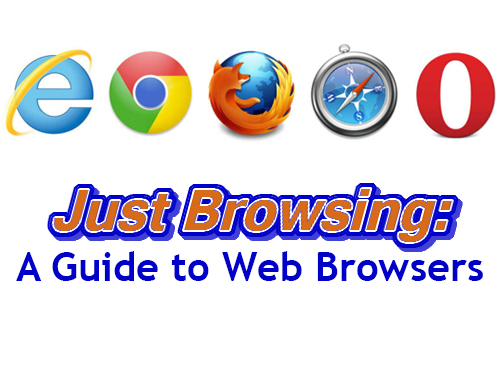
Take a look at the graphic above. What do you see? Well, other than my incredible graphic skills, you’ll notice five different logos. Each logo represents a major web browser. If you’re not sure what a web browser is, let’s turn to our friends at Wikipedia for a definition: “a software application for retrieving, presenting and traversing information resources on the World Wide Web.” In simplest terms, you use a web browser to access the Internet. How many of the logos do you recognize? All users with Windows computers distinguish the “e” as the logo depicting Internet Explorer. If you never knew you had a choice of browser, you do, and best of all they’re all free! Today, we’ll take a look at Internet Explorer, Google Chrome, Mozilla Firefox, Safari, and Opera.
As mentioned before, the logo all the way on the left represents Internet Explorer. Developed by Microsoft, it comes installed as the default browser on all Windows operating systems. Because of this, it’s on more devices than any other browser making it a target of malicious attacks as hackers use many resources learning and exploiting any security vulnerabilities that exist. To Microsoft’s credit, they constantly develop new updates (see prior blog post “Windows Update – Why Bother” for more information) and versions to combat this. The biggest shortcoming with Internet Explorer is its speed. It is by far the slowest of the five browsers on our list. It offers many of the same features as the others, but the speed at which pages are accessed and displayed is lacking. One thing that I personally find aggravating is when ads get between the page I’m currently on and the one I was just at. The only way around it is to right-click the “back” button and select the true last page I was on from the list. If you hit the “back” button it should take you back to the last page without this extra step!
The second logo from the left is that of Google Chrome. Google Chrome is the browser I use on a daily basis. It’s not just me either, as it’s currently the most used browser in the world. Aside from its blazing speed, the biggest asset that Chrome has going for it is the ability to sync bookmarks (favorites) and preferences with a Google account. If you use Gmail, you have an account. Simply sign in with this account and begin customizing your browsing experience. Head to another computer or smartphone, sign in, and everything will appear as you’ve left it. Google Chrome automatically updates itself to make sure you’re protected, and it uses built-in malware and phishing protection to keep you safe. Chrome also offers the ability for you to remotely access your computer from anywhere in the world. Crazy.
Smack dab in the middle of our graphic is the logo for Mozilla Firefox. Firefox is perenially the most critically acclaimed web browser. It’s the fastest and most customizable browser available. Like Google Chrome, Firefox allows you to sync your bookmarks, tabs, and passwords though you do have to create an account to do so. Here are two big highlights: spell checker as you type and session restore. From the posts I’ve read on Facebook, there’s definitely a need for spell check! Session restore is helpful because it will open exactly as you’ve left it, even if the program closes unexpectedly. It can even restore in progress e-mails as well as downloads that were interrupted. Who couldn’t use that?
Next on the list is Safari. If you own an Apple computer or one of their devices be it, iPad, iPod, or iPhone you’ve used Safari. Safari is to Apple as Internet Explorer is to Microsoft. If you’re using a Windows computer or Windows phone and you’re a Safari fan don’t lose heart because it will work with Windows. Safari’s speed is comparable to Firefox so it’s at the top of the browser food chain in that respect. In my opinion, the best feature Safari offers is the “Read” button. If you click the “Read” button the website will display only text. No pictures, no ads, just text. If you’re not at your computer and want to use your smartphone, this feature makes life a lot easier. The downfall of Safari is its lack of customization. This is a barebones browser compared to the others.
Last, but not least, we see Opera. Believe it or not, Opera was first made available to the public in 1995! It’s the least known browser on our list, but the second oldest after Internet Explorer. Go figure. Anyway, if speed is what you seek, it’s comparable to Google Chrome. Opera is probably the most accessible browser on our list. It’s possible to control most features of the browser with just a keyboard. You can use voice commands to surf the web, and even have web sites read to you! Despite these features, Opera lags behind other browsers due to compatibility issues with many sites.
So, there you have it, a quick overview of the giants of the web browser industry. If we went into great detail about these five our blog post would resemble War and Peace! Feel free to download any and all of these browsers and experience them for yourself. There’s more to life than Internet Explorer, even if you’re “Just Browsing.”
